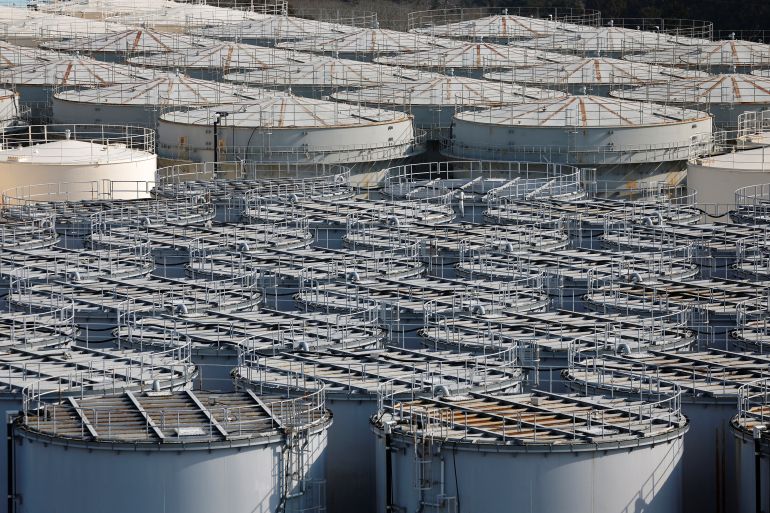Why is Japan’s Fukushima water release so controversial?
The United Nations atomic watchdog is expected to give its approval to the plan, but controversy continues.

The United Nations’ nuclear watchdog is set to give its backing to Japan’s plan to release millions of tonnes of treated radioactive water from the tsunami-wrecked Fukushima Daiichi power plant into the Pacific Ocean.
International Atomic Energy Agency (IAEA) chief Rafael Grossi began a four-day visit to Japan on Tuesday, where he is due to deliver the final outcome of the agency’s two year review into the plan’s safety.
The proposal for the release of the more than 1.33 million cubic metres of water that has accumulated on the site since the 2011 nuclear disaster, has encountered fierce resistance from Japan’s neighbours and countries in the Pacific region.
Fishing industry bodies and civil society groups in Japan have also expressed concern.
“We will continue to explain the safety of the plan to release the treated water into the ocean to the international community, based on scientific evidence and with transparency,” Japanese Foreign Minister Yoshimasa Hayashi said at a joint briefing with Grossi.
Grossi is due to visit the Fukushima plant with Japanese Prime Minister Fumio Kishida on Wednesday and will travel to South Korea, New Zealand and the Cook Islands after he leaves Japan.
Here are some questions and answers about the controversial plan.
Where does the processed water come from?
The radioactive water has been building up at the plant since the March 2011 tsunami destroyed its electricity and cooling systems and triggered the world’s worst nuclear disaster since the Chornobyl explosion.
Most of the water comes from cooling the three damaged reactors, with an extensive pumping and filtration system known as the advanced liquid processing system (ALPS) extracting tonnes of newly contaminated water every day, filtering out most of the radioactive elements.
The rest is from the rain that has fallen onto the contaminated site, and groundwater.
The treated water is stored in more than 1,000 tanks built by plant operator Tokyo Electric Power (TEPCO) and now amounts to more than 1.3 million tonnes – enough to fill 500 Olympic-sized swimming pools – and close to capacity.
The water also needs to be removed so the wrecked plant can be decommissioned.
What are the concerns about radioactive isotopes?
Many of the plan’s opponents are concerned about the presence of tritium, a radioactive isotope of hydrogen.
It remains in the water even after it has been through the ALPS process, which is designed to remove the radioactive isotopes and ensure the treated liquid meets international safety standards.
Tritium is considered relatively harmless because it does not emit enough energy to penetrate human skin. The IAEA says it may present a radiation hazard if inhaled or ingested but is only harmful to humans in very large doses.
Some scientists say the effect of long-term, low-dose exposure to radionuclides is unknown. Others say the release plan is safe but call for more transparency in sampling and monitoring of the release.
Japan has argued the treated water will be diluted to well below internationally approved levels of tritium before being released into the Pacific Ocean.
All the IAEA’s interim evaluations have been positive and the final report is expected to say that the water sampling, testing and monitoring plans involved in the release meet international requirements.
Why are some opposed to the plan?
South Korea, Pacific nations and China have all criticised the plan, with Beijing emerging as one of the most vocal opponents.
On Tuesday, Beijing again called for the plan’s suspension saying the IAEA’s report could not be a “pass” for the water release.
Pacific islands, some of which are still dealing with the legacy of nuclear weapons testing by the United States, France and the United Kingdom from the 1940s to late last century, are also opposed to any nuclear activities in the region fearing additional contamination.
Japanese fishing communities, meanwhile, are worried that the livelihoods they have worked hard to rebuild following the 2011 crisis will once again be destroyed.
After the 2011 disaster, some countries including South Korea banned seafood and agricultural products from Fukushima because of safety concerns.
Despite warming relations between Tokyo and Seoul, the government has said the ban will remain in force because of concerns about radiation.
The US Food and Drug Administration lifted its last remaining restrictions on Japanese food imports in 2021, following a similar move by the European Union.
When and how will the water be released?
When the plan was announced in 2021, the expectation was that the release would begin in about two years.
Japanese regulators finished their final safety inspection of the equipment last Friday and TEPCO is expected to receive a permit for discharging the water in about a week. It could start the process anytime after that, but no firm date has been announced.
The discharge will take place over decades via a pipe extending about 1 kilometre (0.6 miles) from the site of the nuclear plant.
-al jazeera






